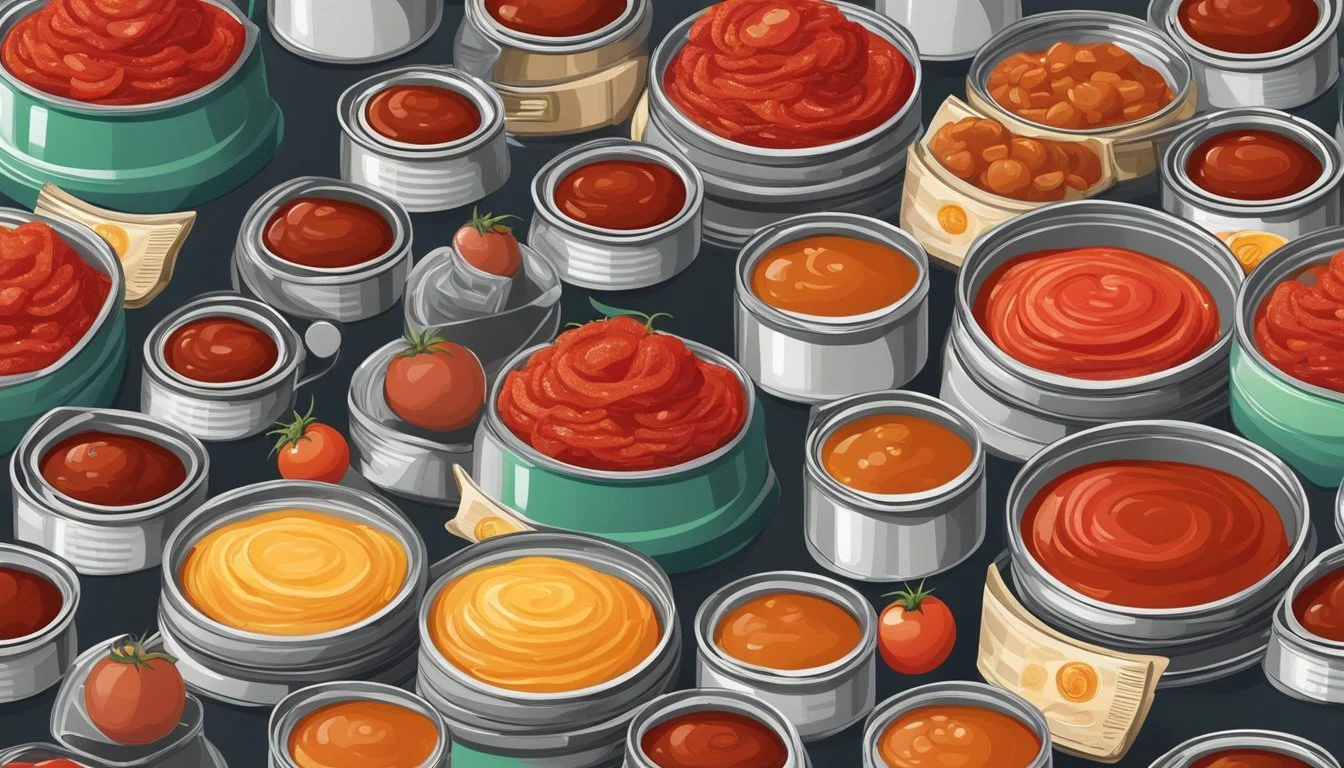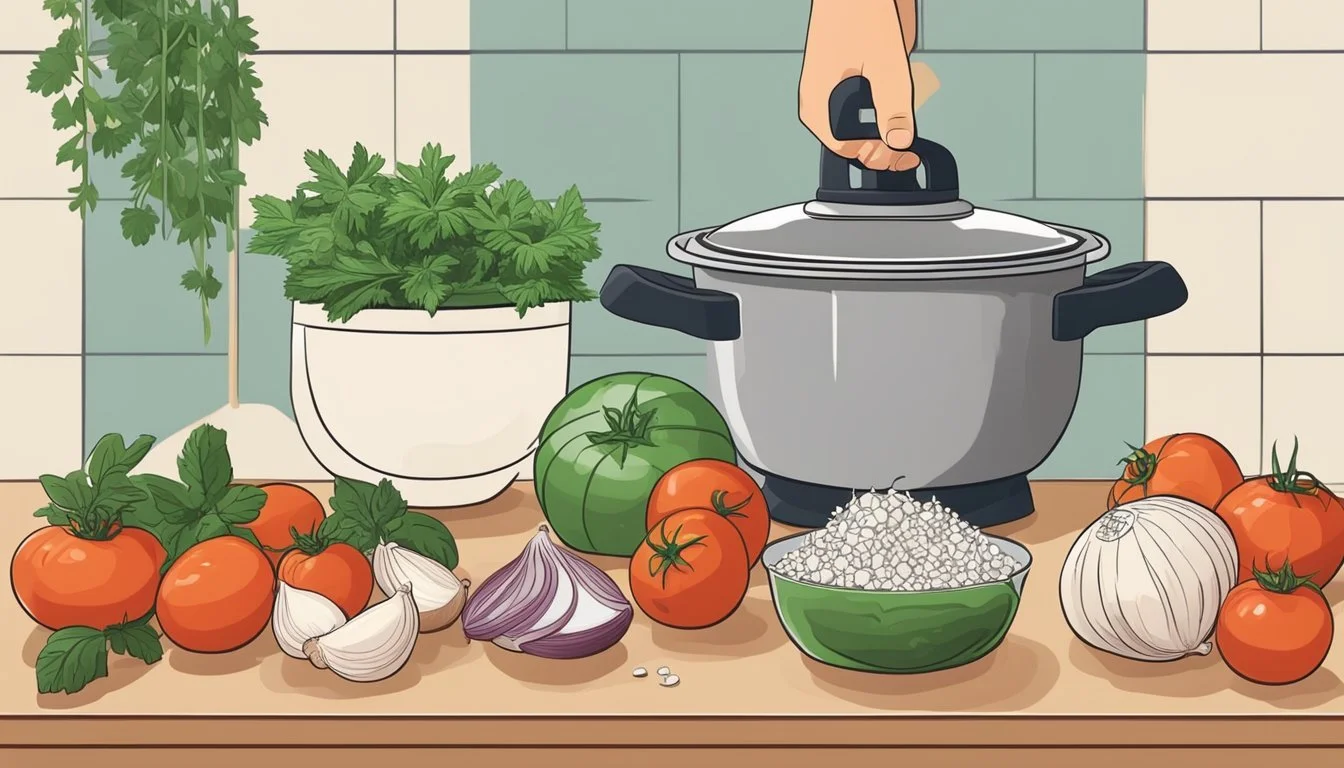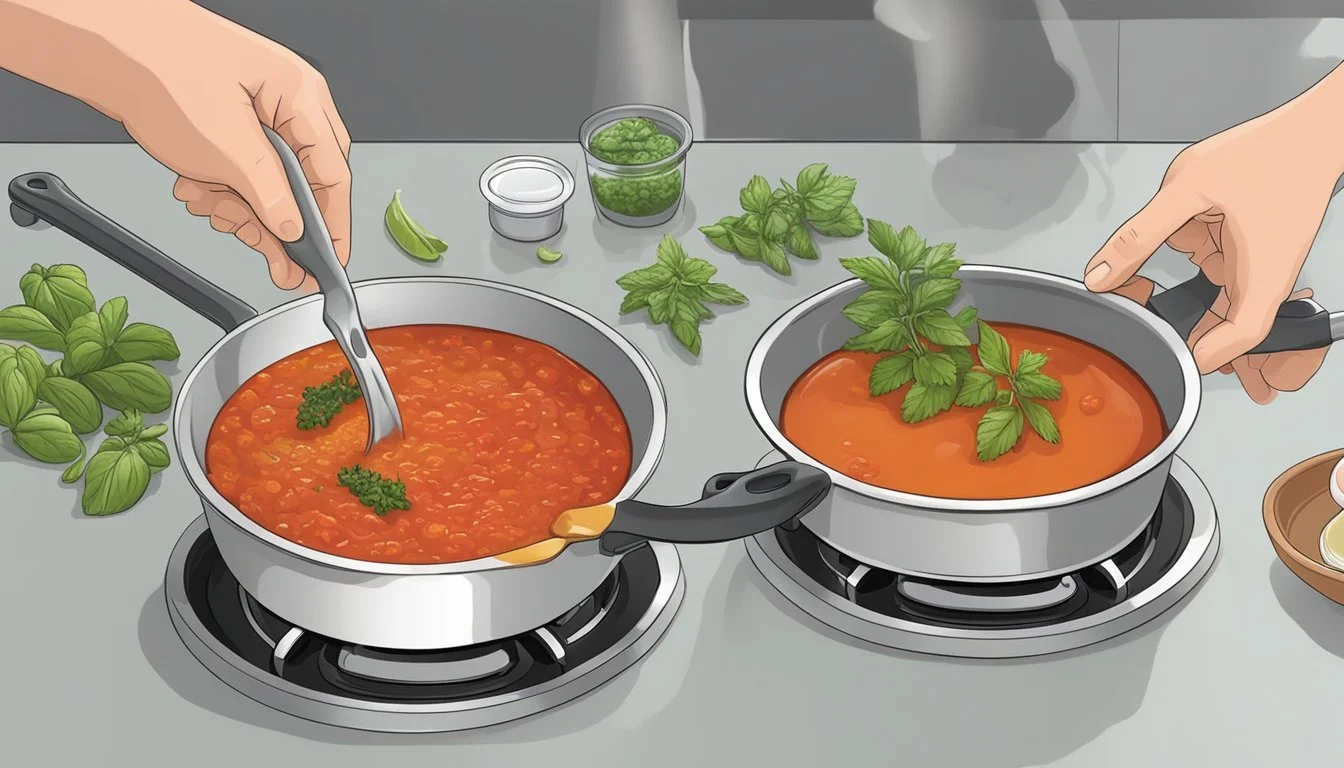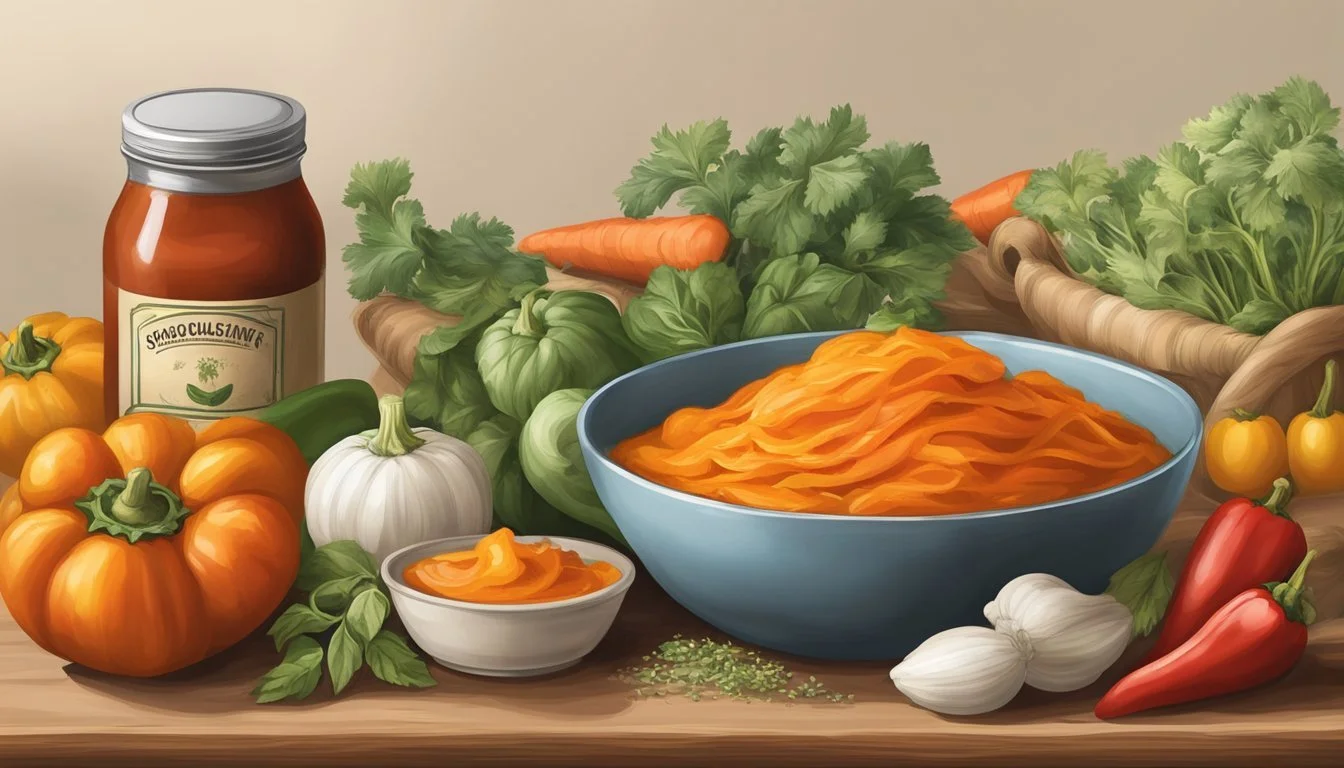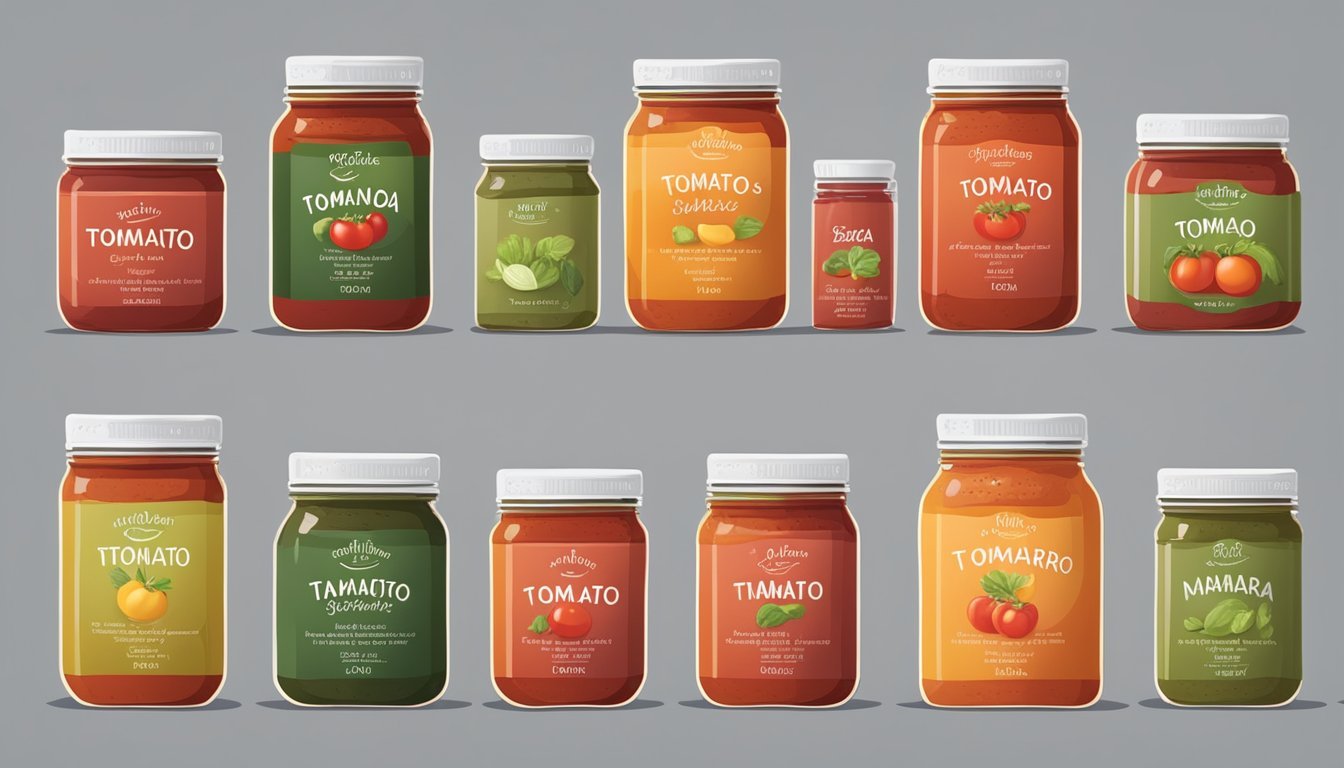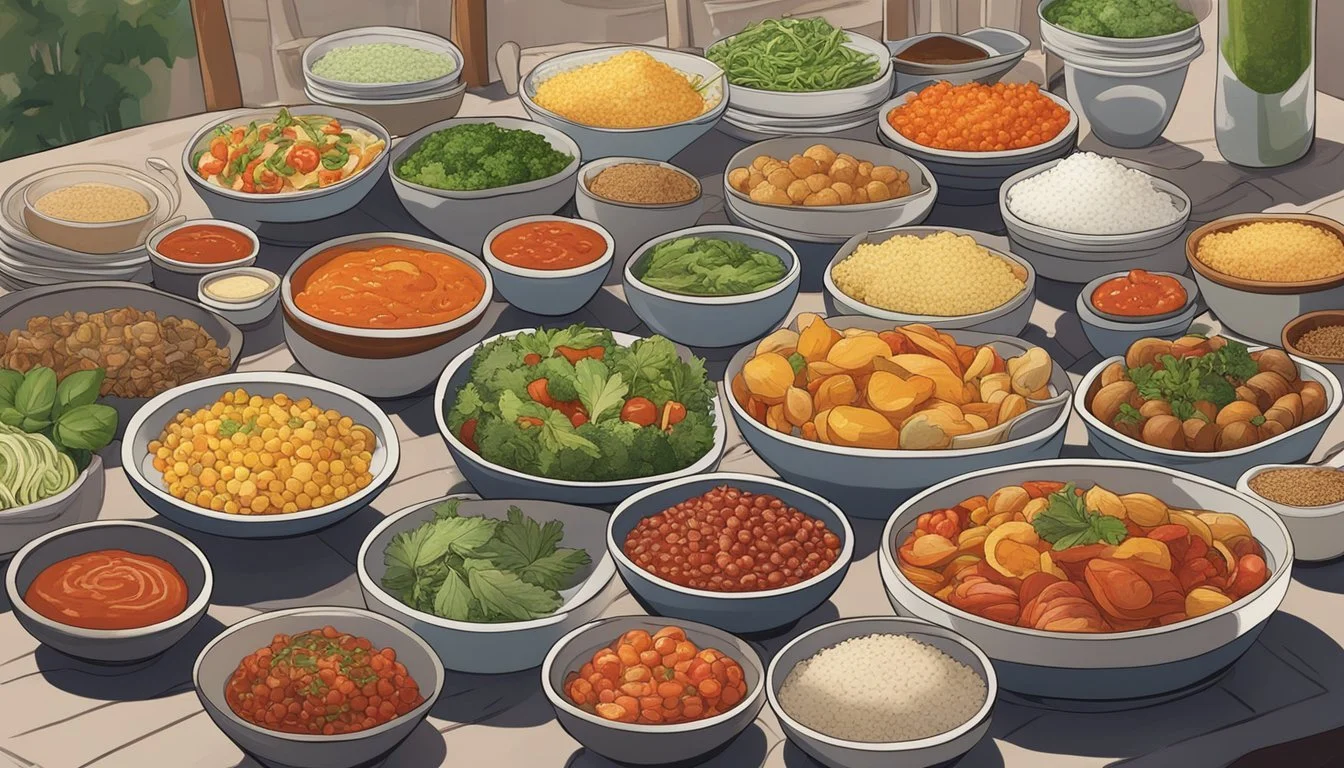Tomato Sauce Substitutes
Top Alternatives for Your Recipes
Cooking often requires adaptability, especially when the pantry lacks a few key ingredients. When tomato sauce is missing from the shelf, cooks need not worry as there are several substitutes that can step in and save the recipe. Whether one is concocting a pasta dish, a casserole, or a stew, the role of tomato sauce can be effectively filled by alternatives like ketchup, tomato paste, or even a can of tomato soup. These substitutes not only provide the desired tomato flavor but also offer a chance to tweak and personalize the taste of the dish.
Understanding the nature of these substitutes is crucial to a successful culinary substitution. Ketchup, for instance, while sweeter and spicier, can be balanced with additional herbs and spices. On the other hand, tomato paste is more concentrated and thus, might require dilution with water or another liquid to achieve a sauce-like consistency. Additionally, those seeking a less processed option may choose fresh tomatoes, which can be pureed and seasoned to stand in for sauce. Each of these options can deliver the rich, tangy flavor profile that is characteristic of tomato-based dishes, ensuring the end result is both delicious and satisfying.
Experimenting with these substitutes can not only rescue a meal in progress but also expand a cook's repertoire, introducing new textures and flavors. While the ideal substitute often depends on the particular recipe and desired outcome, having a handful of go-to alternatives can make meal preparation more flexible and stress-free. Knowledge of proper ratios and seasoning adjustments is key to ensuring these alternatives successfully mimic the taste and function of traditional tomato sauce, allowing them to seamlessly blend into the dish.
Understanding Tomato Sauce
Tomato sauce is a staple in various cuisines, serving as a foundational ingredient that lends both flavor and texture to dishes. Its preparation and application are essential in creating classic meals like spaghetti, pizza, and lasagna.
Composition of Tomato Sauce
Tomato sauce typically consists of tomatoes as the base, either freshly pureed or from a canned variety. It is seasoned with herbs and spices to enhance its taste. The typical composition of tomato sauce includes:
Tomatoes (fresh or canned): The primary ingredient that provides the characteristic taste and texture.
Seasonings: Such as salt, garlic, onion, and sugar, to balance acidity and sweetness.
Herbs: Commonly basil and oregano, contributing to the sauce’s authentic flavor.
Fat: Often olive oil, which carries flavors and adds richness.
A well-prepared tomato sauce strikes a balance between acidity and sweetness, with a texture that can range from chunky to smooth, depending on the preparation and desired outcome.
Culinary Uses of Tomato Sauce
Tomato sauce is versatile in the kitchen, serving as a crucial component in many dishes. Its uses include:
Spaghetti and other pasta dishes (What wine goes well with pasta dishes?): Where the sauce clings to the pasta and imparts moisture and flavor.
Pizza: Acting as a flavorful base for toppings.
Lasagna: Layered between sheets of pasta, contributing to the dish’s moisture and taste.
Tomato sauce often acts as the backbone of many recipes, setting the stage for a harmony of flavors. Its role is not just to serve as a topping or a dip but to integrate with other ingredients, elevating the overall taste profile of a dish. Substitutes for tomato sauce must therefore match the expected consistency and flavor profile to maintain the integrity of these time-honored recipes.
Common Tomato Sauce Substitutes
When a recipe calls for tomato sauce and none is at hand, a cook can leverage common pantry staples to create a comparable substitute that maintains the desired texture and taste of the dish.
Tomato Paste and Water
Tomato paste, when diluted with water, serves as a thick, concentrated source of tomato flavor used to replace tomato sauce. To mimic the consistency and volume of tomato sauce, combine one part of tomato paste with one part of water, stirring until smooth.
Canned Tomatoes
Canned tomatoes, whether whole, diced, or crushed, are an excellent stand-in for tomato sauce after being blended to the desired texture. Their natural juices provide a suitable liquid base, and the cook may add water if a thinner consistency is needed. Seasonings like salt and sugar can adjust the taste according to the recipe's requirements.
Tomato Soup
Tomato soup can be a convenient substitute, especially in casseroles (What wine goes well with casseroles?) or stews. To account for its typically thinner consistency and additional seasonings, adjust the quantity of wet ingredients in the recipe accordingly, reducing them to prevent excessive liquidity.
Vegetable-Based Alternatives
When looking for a non-tomato based sauce, numerous vegetables can offer the rich texture and flavor desired in a variety of dishes. Suitable for those with allergies or health reasons, these alternatives can be made smooth in a food processor and seasoned to taste.
Pureed Bell Peppers
Bell peppers are an excellent tomato sauce alternative due to their sweet flavor and vibrant color. To prepare, one should blend red, orange, and yellow bell peppers until smooth, resulting in a colorful and homemade 'nomato sauce'. This can be especially synergistic in dishes like stuffed peppers or fajitas.
Eggplant Sauce
A homemade eggplant sauce serves as a savory and hearty substitute. Individuals can roast or sauté eggplants until tender, remove the skin, and then puree with a food processor, adding olive oil, spices, and water as needed for consistency. This is a particularly fitting choice for Italian dishes, such as "eggplant parm."
Beets and Carrots
Beets and carrots, when blended, can mimic the depth of tomato sauce with their earthy and subtly sweet undertones. This alternative is not only vibrant but also nutrient-rich. They introduce a homemade touch to dishes that require a robust sauce base.
Non-Tomato Condiment Options
When seeking alternatives to tomato sauce, individuals often overlook versatile condiments already present in their pantries. Two such options include ketchup and marinara sauce, both of which can be used successfully in various dishes with slight modifications.
Ketchup
Ketchup, a common household staple, can serve as a tomato sauce substitute due to its tomato base and similar consistency. To use ketchup as an alternative, one should:
Replace on a 1:1 ratio (1 cup ketchup for 1 cup tomato sauce)
Adjust flavor with added spices, such as:
Basil or oregano for Italian dishes
A pinch of salt and sugar to balance sweetness and tanginess By incorporating these spices, the dish retains its intended flavor profile, compensating for ketchup's distinct taste.
Marinara Sauce
Marinara sauce, while tomato-based, has a different blend of seasonings and a lighter texture compared to traditional tomato sauce. To substitute with marinara:
Use equal amounts of marinara in place of tomato sauce
Enhance with additional seasonings like:
Olive oil for richness
Fresh or dried spices to match the dish's original intent The simplicity of marinara sauce makes it a flexible substitute that can be adjusted as per the recipe's needs.
Creating a Homemade Substitute
Creating a substitute for tomato sauce involves leveraging the depth of flavor from spices and the rich mouthfeel provided by oils and fats. Here, the focus is placed on those two critical elements, ensuring the homemade concoction can stand proudly alongside any marinara sauce.
Spices and Herbs Enhancement
When substituting tomato sauce, the blend of spices and herbs is paramount. Basil stands out as a fundamental herb, bringing its signature aroma and slight sweetness often associated with traditional tomato sauces. Incorporation of spices should be purposeful, focusing on those that complement the substitute base, whether it's a vegetable puree or a ketchup base. Aim for balance, using spices to elevate the profile without overpowering.
Here is a table of suggested spices and their typical quantities for a substitute equal to 1 cup of tomato sauce:
Spice Quantity Basil 1 tsp dried Oregano 1/2 tsp dried Ground Garlic 1/4 tsp Onion Powder 1/4 tsp
Use of Oils and Fats
Olive oil is a traditional fat used in many Italian sauces and makes an excellent base for a homemade tomato sauce substitute. It has the dual role of sautéing aromatics and providing a rich, silky foundation. Other oils and fats can also be used depending on dietary restrictions or flavor preference.
For those aiming to replicate a cooked sauce-like feel, consider emulsifying the oil with other components of the substitute to create a cohesive and velvety texture. This can transform an otherwise bland puree, granting it a luxurious quality that's characteristic of a long-simmered marinara.
Remember, moderation is key; typically, 1 to 2 tablespoons of olive oil will suffice for a cup-sized substitute to ensure the result is not overly greasy.
Specialty Substitutes for Specific Dishes
Selecting the right tomato sauce substitute can enhance the distinct flavors of various dishes, such as pizzas, pasta, and casseroles. Each dish has its unique requirements for substitutes that align closely with the original texture and taste profile.
Alternatives for Pizza Sauce
For pizza, one seeks a substitute that complements the dough and toppings without overpowering them. Canned tomatoes, crushed and seasoned with herbs like oregano and basil, can easily stand in for pizza sauce. They maintain a thick consistency while providing a fresh tomato flavor that is key to a good pizza base. A mixture of tomato paste, water, and a drizzle of olive oil can also achieve a similar result. Adjust seasonings as per taste.
Pasta Dish Replacements
Pasta dishes often require a smooth and richly flavored sauce. Pasta sauce, such as marinara or spaghetti sauce, is a ready-to-go alternative that won't alter the dish's expected taste. They can be used in equal parts to replace tomato sauce in recipes such as lasagna or a simple spaghetti dish. If a dense texture is desired, blend sun-dried tomatoes with olive oil and seasoning to create a paste that beautifully complements robust pasta plates.
Casserole-Specific Substitutes
Casseroles benefit from substitutes that offer a depth of flavor and moisture without becoming watery. Tomato passata or puréed tomatoes can replace tomato sauce and keep the casserole hearty. For a lighter tomato flavor, using half the amount of tomato paste mixed with water can serve as a good alternative, depending on the specific casserole recipe. If looking to add a bit more zest, including a splash of wine or stock can elevate the taste.
Seasoning Adjustments and Additions
Successful substitution of tomato sauce often requires careful consideration of the balance between sweetness and acidity, as well as the introduction of spices to achieve a well-rounded flavor profile.
Balancing Sweetness and Acidity
When substituting tomato sauce, achieving the right balance between sweetness and acidity is crucial for mimicking the original sauce's taste and preventing flavor disparities in the final dish. Sugar can be used to increase sweetness, while vinegar or lemon juice may be added sparingly to enhance acidity.
To adjust sweetness and acidity:
Add sugar: 1/2 teaspoon at a time, tasting as you go.
Introduce vinegar or lemon juice: Start with a few drops, adjust to taste.
Enhancing Flavor with Spices
Substitutes for tomato sauce may lack the depth of flavor that the original sauce provides. Spices play a key role in layering flavors and should be selected based on the substitute being used to maintain the integrity of the dish.
Common spices to include:
Salt: Essential for flavor enhancement; add in small increments.
Basil, Oregano, Onion Powder, Garlic Powder: These complement most tomato-based substitutes, bringing in a familiar Italian sauce profile.
Pepper: Adds a hint of heat and sharpness; freshly ground is preferred.
By precise seasoning, one can tailor the substitute to closely resemble the complexity of original tomato sauce, ensuring an enjoyable and harmonious dish.
Considerations for Health and Dietary Restrictions
When seeking alternatives to tomato sauce, individuals must consider their specific health and dietary restrictions. This can include monitoring intake of sodium and sugar, as well as avoiding allergens. The following subsections provide tailored options to meet these needs.
Low-Sodium and Sugar-Free Options
For those monitoring their sodium intake, selecting substitutes with lower salt content is crucial. Tomato paste diluted with water can serve as a low-sodium alternative to tomato sauce, as it allows the individual to control the amount of added salt. Alternatively, pureed fresh tomatoes with fresh herbs offer a flavorful option without added sodium.
For a sugar-free substitute, individuals should look for tomato sauce alternatives that do not contain added sugars. Homemade options using fresh vegetables, such as bell peppers or eggplants, can be pureed to a sauce-like consistency without the need for sugar.
Allergen-Free Alternatives
Tomato allergies are uncommon but can necessitate looking for non-tomato based substitutes. Eggplant is a suitable alternative, though for those with nightshade allergies, a sauce made with sautéed red bell peppers and spices offers a non-nightshade and allergen-free option. These vegetables can be roasted and blended into a puree, ensuring the absence of common allergens.
Storing and Preserving Substitutes
When considering substitutes for tomato sauce, the methods of storage and preservation are fundamental to maintaining flavor and shelf life. Proper techniques ensure that alternatives such as pureed bell peppers or homemade sauces retain their quality over time.
Canning and Jarring Alternatives
Canning and jarring are effective methods to preserve pureed bell peppers and other tomato sauce alternatives. To store these substitutes, they should first be cooked to reduce the risk of spoilage. Once cooked, they can be processed using standard canning procedures.
Canning Steps:
Prepare the alternative sauce by cooking it thoroughly.
Sterilize jars and lids by boiling them for at least 10 minutes.
Fill the jars with the sauce, leaving appropriate headspace, usually about a half-inch.
Wipe the rims to ensure a good seal and apply the sterilized lids.
Process the jars in a boiling water canner or pressure canner according to the substitute's specific recommendations.
Ideal Storage Conditions:
Store the jars in a cool, dark pantry.
The temperature should be steady, ideally between 50°F and 70°F.
Avoid direct sunlight and fluctuating temperatures which can degrade the quality of the contents.
Freezing Homemade Sauces
Freezing homemade sauces that serve as tomato sauce substitutes is a straightforward method of preservation. It is a suitable option for those who do not wish to can or have limited pantry space.
Freezing Guidelines:
Let the sauce cool to room temperature after cooking.
Pour the sauce into airtight containers, freezer bags, or use an ice cube tray for small portions.
Label each container or bag with the date of freezing.
Sauces can typically be frozen for up to six months for optimal flavor.
When ready to use, one can thaw the sauce in the refrigerator or warm it directly over low heat, stirring occasionally. It's essential to use containers that are freezer-safe to prevent freezer burn and preserve taste and texture.
Nutritional Comparisons
In this section, readers will find detailed comparisons of the nutritional profiles of various tomato sauce substitutes, focusing specifically on their calories, macronutrients, as well as their vitamins and mineral content.
Comparing Calories and Macronutrients
Tomato sauce is known for its low-calorie count and moderate macronutrient distribution. Substitutes like eggplant and bell peppers also maintain a low-calorie profile, similar to tomatoes. When considering calorie count and macronutrients like carbohydrates, protein, and fiber, it's important to compare like for like. Here's how a 1/2 cup serving of some common substitutes stacks up against tomato sauce:
Substitute Calories (kcal) Carbohydrates (g) Protein (g) Fiber (g) Tomato Sauce 39 9 1.5 2 Eggplant 20 4.82 0.82 2.5 Bell Peppers 19 4.64 0.76 1.7
These substitutes offer different flavors, but keep the dish light and in alignment with the nutritional profile of traditional tomato-based sauces.
Vitamins and Mineral Content
Tomato sauce is a good source of vitamin C and iron. In contrast, substitutes like roasted bell peppers exceed tomato sauce in vitamin C content but may offer less iron. Here's a brief look at their vitamin and mineral offerings:
Tomato Sauce: High in vitamin C and contains iron.
Eggplant: Provides some B vitamins and minerals, but not as rich in vitamin C or iron.
Bell Peppers: Exceptionally high in vitamin C, especially red bell peppers, with a decent amount of iron.
These substitutes not only alter the flavor of dishes but also impact the nutritional value, providing consumers with a range of vitamins and minerals. Their unique nutritional profiles can cater to various dietary needs and preferences.
Innovative Tomato Sauce Substitutes
Exploring innovative tomato sauce substitutes can both broaden culinary horizons and cater to dietary restrictions. This section delves into recent market innovations and homemade alternatives that maintain the essence of traditional tomato sauce while providing a fresh twist.
Market Innovations and New Products
The food industry has responded to consumer demand for alternative products with some notable innovations. Tomato powder is one such product, offering a concentrated flavor that, when rehydrated with hot water, serves as an effective and longer-lasting substitute for tomato sauce. Market innovators have also introduced V8 juice as a multi-vegetable alternative that captures the essence of tomatoes and blends it with the flavors of other vegetables, creating a nutrient-rich and versatile sauce base.
Market Product Description Tomato Powder Concentrated, shelf-stable, and easily rehydrated. V8 Juice Vegetable blend juice with a tomato base, ready to use.
Homemade Creative Alternatives
Home cooks are continually experimenting with substitute ingredients to replicate or enhance the flavor profile of tomato sauce. Sun-dried tomatoes, with their sweet-tart taste, can be blended with olive oil and seasoning to make a thick, rich substitute. Another unique addition to the home cook's repertoire is ajvar, a traditional Balkan red pepper relish. With its savory and slightly smoky flavor, ajvar can be modified to mimic the complexity of tomato sauce in various dishes.
Homemade Alternative Description Sun-Dried Tomatoes Blended to create a paste-like substitute with robust flavor. Ajvar Red pepper relish used for its savory and smoky notes.
Understanding Substitute Textures
When seeking alternatives for tomato sauce, texture plays a pivotal role in determining the most suitable substitute. These substitutes can range from a smooth purée to a more robust, chunky consistency, impacting the feel and overall experience of the dish.
From Smooth to Chunky
A smooth texture is often desired for dishes that require a seamless integration of tomato flavor without altering the dish's consistency. Tomato powder rehydrated with equal parts of hot water can embody this silky quality. Substitutes like tomato paste diluted with water, or even tomato soup thinned out as needed, provide a similar velvety texture.
For dishes that benefit from a chunkier element, crushed tomatoes can be a perfect match. These tomatoes lend a robust texture, giving a heartier presence in recipes such as rustic pastas or stews. One can even consider using sun-dried tomatoes, finely chopped to add a sweet-tart dimension with a more substantial bite.
Adjusting Thickness
The key to modifying the thickness of a tomato sauce substitute lies in the manipulation of water content. Here are specific recommendations:
Smooth Sauces: Start with a 1:1 ratio of substitute to water and adjust accordingly.
Chunkier Sauces: Use the substitute as is, or add a small amount of extra water to achieve the desired consistency.
Substitute Starting Ratio Adjustments for Thickness Tomato Powder 1:1 Increase water for thinner sauce Diluted Tomato Paste 1:1 Add water gradually for a smoother texture Crushed Tomatoes As is Add extra water to thin out if necessary Sun-Dried Tomatoes As is Chop finely for desired texture consistency
It should be noted that one may also tweak the texture by simmering tomato-based liquids, allowing excess water to evaporate and the sauce to thicken. This method is particularly useful when working with tomato juice or bisque as alternatives.
The Role of Tomato Sauce in Various Cuisines
Tomato sauce is a staple ingredient that forms the base for a myriad of dishes spanning multiple cuisines. It provides essential flavor and moisture and is a fundamental component in many beloved recipes.
Italian Cuisine
In Italian cuisine, tomato sauce is critical not only for its tangy flavor but for its versatility. Marinara sauce, a simple tomato sauce with garlic, basil, and oregano, often serves as the foundation for pasta dishes. Spaghetti and meatballs, a classic Italian-American dish, traditionally features spaghetti drenched in a hearty tomato sauce accompanied by succulent meatballs. In Italy, the sauce used with pasta is typically lighter and cooked for a shorter duration compared to the thick sauces favored elsewhere.
Tomato sauce is also indispensable in pizza making, where a variant known as pizza sauce is used. Unlike marinara sauce, pizza sauce is often thicker, with a more concentrated tomato flavor, designed to complement the dough and toppings without making them soggy.
Key Italian Dishes With Tomato Sauce:
Spaghetti and meatballs
Lasagna
Margherita Pizza
American Favorites
In American cuisine, tomato sauce is synonymous with comfort food. The sauce is crucial in a wide range of American favorites, often lending a zestful and rich component to the overall taste profile. Pasta dishes such as spaghetti, lasagna, and various casseroles often have tomato sauce as a key ingredient. This sauce introduces a unifying factor that melds the flavors of meats, vegetables, and herbs present in these dishes.
Beyond pasta, tomato sauce is used for sloppy joes, chili, and as a base for barbecue sauces. It is a versatile kitchen player that can be found in pantries across the United States.
American Dishes Featuring Tomato Sauce:
Chili
Meatloaf
Barbecue sauce bases
Troubleshooting Common Substitution Issues
When utilizing substitutes for tomato sauce, a cook may encounter issues related to taste and texture. Careful adjustments can help manage these differences, ensuring the final dish meets expectations.
Taste Corrections
Tomato sauce imparts a distinct sweet and tangy profile to dishes. When using substitutes, taste may vary significantly, requiring corrections to achieve a similar flavor. Here are specific adjustments one might consider:
Sugar: If a substitute is too acidic, one can add a pinch of sugar to balance the flavors.
Spices and Herbs: Incorporate basil, oregano, or thyme to mimic the herbal undertones of tomato sauce.
Substitutes Taste Adjustments Needed Tomato Paste Add water and a pinch of sugar to dilute and sweeten. Canned Tomatoes Blend with herbs and adjust seasoning to match the sweetness.
Texture Modifications
The texture of a good tomato sauce is smooth yet thick enough to coat the pasta or other components of the dish. Substitutes may require modifications to achieve the desired consistency:
Thickening: For watery substitutes, simmering can help thicken the sauce. Alternatively, one can incorporate a small amount of cornstarch slurry.
Pureeing: To smooth out chunky alternatives like canned tomatoes or roasted bell peppers, one should blend the substitute to the desired consistency.
Substitutes Texture Adjustment Needed Tomato Soup Thin out with water for a sauce-like consistency. Roasted Bell Peppers Puree to smooth out the texture before using as a sauce.
Exploring the Color Palette of Substitutes
When considering alternatives to tomato sauce, one important aspect is the visual impact on the final dish. Different substitutes can offer a wide range of colors, from the familiar vibrant red to more earthy tones, affecting not only the taste but also the presentation.
Vibrant Red to Earthy Tones
Tomato Puree: Offers a deep red color, closely mimicking the hue of tomato sauce.
Roasted Tomatoes: Can provide a rich, slightly darker red with a more concentrated flavor.
The color of a substitute such as nomato sauce—a blend of vegetables like carrots and beets—can vary from a lighter red to an earthy orange, depending on the specific ingredients used and their proportions. This variation offers an alternative visual profile while maintaining some semblance to the color of traditional tomato sauce.
Visual Appeal in Dishes
Substitute Color Visual Effect in Dish Tomato Puree Vibrant Red Maintains the classic look of tomato-based dishes Roasted Tomatoes Darker Red Adds a rustic appeal Nomato Sauce Ranges from Red to Earthy Orange Offers a unique twist, yet familiar to the eye
The appearance of a dish is as important as its taste, with color playing a key role in culinary presentation. For instance, using tomato puree retains the conventional red color of tomato sauce, while substitutes like nomato sauce suit those seeking to replicate the visual aspect with slight variation. The choice of substitute can be tailored to not only fit dietary preferences or restrictions but also complement the aesthetic of the dish being prepared.
Frequently Asked Questions
In this section, readers will find detailed answers to common questions about using tomato sauce substitutes in various recipes and tips on their shelf life and storage.
Substitutes in Popular Recipes
When one's pantry is missing an essential ingredient like tomato sauce, it's important to know reliable substitutes that can be applied across a range of popular recipes.
Spaghetti Sauce Replacement: One can use an equal amount of crushed tomatoes, adding water to thin it out if necessary, and seasoning to taste.
Pizza Sauce Alternative: A blend of equal parts sun-dried tomato pesto and water can provide the requisite consistency and flavor.
General Cooking: Tomato powder rehydrated with hot water in a 1:1 ratio can act as a convenient substitute in a variety of dishes where tomato sauce is called for.
Shelf Life and Storage Queries
Proper storage ensures the longevity and quality of tomato sauce substitutes. Here's how to handle common pantry items used as substitutes:
Crushed Tomatoes: Should be stored in a cool, dry place and, if opened, refrigerated and used within 5-7 days.
Sun-Dried Tomato Pesto: Unopened jars can be kept in the pantry, but after opening, they should be refrigerated and consumed within 2 weeks.
Tomato Powder: This shelf-stable product, when kept in an airtight container away from moisture, can last for up to a year in the pantry.
Conclusion
When traditional tomato sauce is unavailable, a variety of substitutes offer culinary versatility and confidence in the kitchen. Home cooks can consider the flavor profile and texture of these alternatives to achieve a desirable outcome. Here's a succinct guide:
Tomato Paste and Water: For a straightforward replacement, mix equal parts of tomato paste and water to mimic the consistency of tomato sauce. Season to taste to enhance flavor.
Ketchup: While sweeter, ketchup can stand in for tomato sauce. Spice it up with herbs like basil to offset sweetness.
Tomato Soup: It serves as an immediate alternative, but requires reducing additional liquids in the recipe to maintain consistency.
Sun-Dried Tomatoes: Rehydrate these with hot water for a sauce with a sweet-tart profile. Adjust the water for your desired thickness.
Tomato Powder: Mix with water to reconstitute into a sauce-like consistency, also customizable to one’s preference.
Each option is an expedient pathway to achieve a sauce with similar attributes to the original tomato sauce. These alternatives ensure a dish maintains its essence, even when adapting to ingredient constraints. The cook maintains a harmonious balance in flavors while exploring the different dimensions these substitutes provide.

